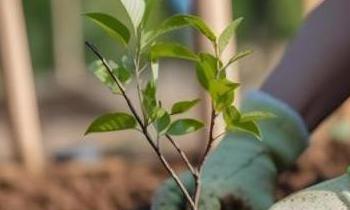
The sight of lush green trees thriving and providing a refreshing atmosphere is truly a marvel to behold. However, there are times when trees face difficulties in their growth and fail to reach their full potential. In this article, we will explore the various reasons behind stunted tree growth and discuss effective preventive measures. By understanding the factors that hinder tree growth and implementing appropriate solutions, we can help ensure the health and vitality of our precious green companions.
Proper nutrition is vital for the growth and development of trees. When trees lack essential nutrients, such as nitrogen, phosphorus, and potassium, their growth may be hindered. Nutrient deficiencies can be caused by poor soil quality, inadequate fertilization, or competition with other plants. To prevent these issues, it is crucial to perform regular soil testing, choose suitable fertilizers, and apply them in the correct amounts at the appropriate times. Additionally, practicing proper mulching techniques can help retain moisture and enhance nutrient availability for tree roots, thereby supporting healthy growth.
Soil plays a significant role in tree development. Certain soil conditions can impede tree growth, such as compacted soil, excessively clayey or sandy soil, and poor drainage. Compacted soil restricts root growth, reducing nutrient and water absorption. In contrast, excessively clayey or sandy soil may struggle to retain moisture or provide adequate aeration for the roots. Improving soil structure through techniques like soil aeration, amending with organic matter, and installing drainage systems can help create a favorable environment for tree roots to establish and flourish.
Trees are highly sensitive to climatic conditions. Extreme temperatures, drought, frost, and excessive rainfall can all negatively impact tree growth. When faced with such challenges, trees may exhibit signs of stress, such as wilting, leaf discoloration, or reduced growth. To mitigate the effects of an unfavorable climate, it is crucial to choose tree species that are well-adapted to the local climate conditions. Providing supplemental irrigation during drought periods and protecting trees from frost or excessive heat through shading or mulching can also help safeguard their growth and survival.
Pests and diseases pose a significant risk to tree health. Insects like aphids, beetles, and borers can weaken trees by feeding on leaves, bark, or roots. Fungal and bacterial infections can cause diseases that manifest as leaf spots, cankers, or wilting. Regular inspection of trees for signs of infestation or disease is crucial. Employing appropriate pest management techniques, such as biological controls, cultural practices, and judicious use of pesticides, can help combat these threats effectively. Maintaining overall tree health through proper pruning, adequate irrigation, and avoiding injuries to trunks or branches also strengthens their resistance to pests and diseases.
Competition from nearby plants, including grasses and weeds, can rob trees of essential resources, including light, water, and nutrients. Ensuring a clear area around the base of the tree by mulching or removing competing vegetation can alleviate this issue. Mechanical damage, caused by lawnmowers, construction equipment, or improper pruning techniques, can also hamper tree growth. It is crucial to be mindful of these risks and take necessary precautions to prevent damage. Regularly inspecting trees for signs of injury and promptly addressing any concerns can significantly contribute to their well-being.
Water is a fundamental requirement for tree growth and survival. Insufficient water supply can severely impact their ability to thrive. Inadequate rainfall, limited irrigation, or improper watering practices can lead to drought stress and hinder growth. To prevent water-related issues, it is crucial to provide trees with an appropriate amount of water based on their species and age. Deep and infrequent watering encourages deep root growth and enhances the tree's ability to withstand drought conditions. Mulching around the base of the tree helps retain soil moisture and reduces water evaporation, ensuring efficient water usage.
Improper planting techniques can contribute to the long-term health and growth issues of trees. Planting trees too deeply or too shallowly, failing to loosen the root ball, or disturbing the root system excessively during transplantation can all impede growth. It is crucial to follow proper planting guidelines, including selecting the right planting location, digging a wide and shallow planting hole, and ensuring the root flare is level with or slightly above the ground. Additionally, providing appropriate support, such as staking, during the establishment phase can prevent structural damage and support healthy growth.
Regular maintenance is essential for the well-being of trees. Neglecting essential care practices such as pruning, removing deadwood, or addressing structural issues can hinder growth and make trees susceptible to pests and diseases. Pruning helps promote healthy branching, removes damaged or diseased parts, and enhances air circulation. Regular inspections enable the early detection of any potential problems. It is crucial to engage in routine tree care activities and consult with arborists when needed to ensure proper tree maintenance and prevent long-term growth constraints.
In our quest to promote healthy tree growth, it is essential to recognize and address the various factors that can hinder their development. By understanding the significance of proper nutrition, soil conditions, climate adaptation, pest management, and minimizing competition and mechanical damage, we can create an environment conducive to vibrant tree growth. Through careful attention and preventive measures, we can ensure a flourishing canopy that enriches our surroundings and supports the well-being of both nature and humanity.

Deforestation, a pressing global issue, refers to the permanent removal of trees and vegetation from forests.
01-04-2023

In our ever-evolving world, the importance of ecological balance cannot be overstated. As we strive to combat
28-02-2023

In an era dominated by climate change and environmental concerns, planting trees emerges as a powerful solutio
28-02-2023

In a world where the green canopy of nature is often overshadowed by concrete, planting trees and shrubs becom
20-02-2023

Are you ready to embark on a gardening adventure and bring life to your surroundings? The key to successful pl
19-12-2022